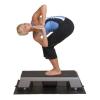CYBERMED LIFE - ORGANIC & NATURAL LIVING
CYBERMED LIFE - ORGANIC & NATURAL LIVING
 Whole body vibration (WBV) is a generic term used when vibrations (mechanical oscillations) of any frequency are transferred to the human body. Humans are exposed to vibration through a contact surface that is in a mechanical vibrating state. Human's are generally exposed to many different forms of vibration in their daily lives. This could be a driver's seat, a moving train platform, through a power tool, a training platform, or one of countless other devices. It is a potential form of occupational hazard, particularly after years of exposure.
Whole body vibration (WBV) is a generic term used when vibrations (mechanical oscillations) of any frequency are transferred to the human body. Humans are exposed to vibration through a contact surface that is in a mechanical vibrating state. Human's are generally exposed to many different forms of vibration in their daily lives. This could be a driver's seat, a moving train platform, through a power tool, a training platform, or one of countless other devices. It is a potential form of occupational hazard, particularly after years of exposure.
When high frequency vibrations (above 50 Hz) enter though the hands, occupational safety concerns may arise. For example, when working with a jackhammer and the development of vibration white finger. Exposures and limits have been estimated in the ISO 5349-1 for hand-transmitted vibration.
Whole body vibration training as a form of physical exercise can offer some fitness and health benefits, but it is not clear if it is as beneficial as regular physical exercise. A review in 2014 came to the conclusion that there is little and inconsistent evidence that acute and/or chronic whole body vibration could improve the performance of competitive and/or elite athletes.